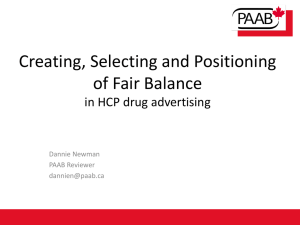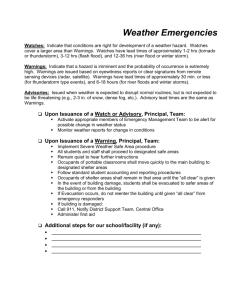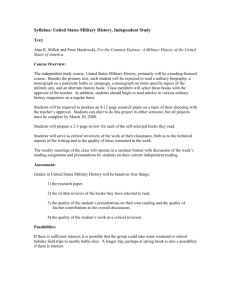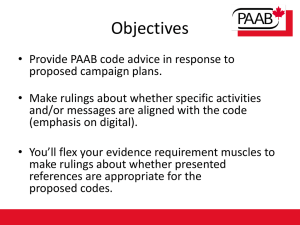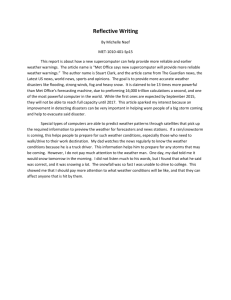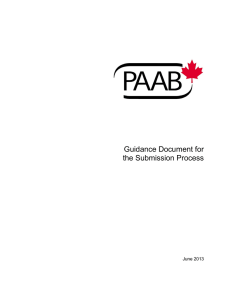Guidance on Generating the Three Base Fair Balance Levels
advertisement
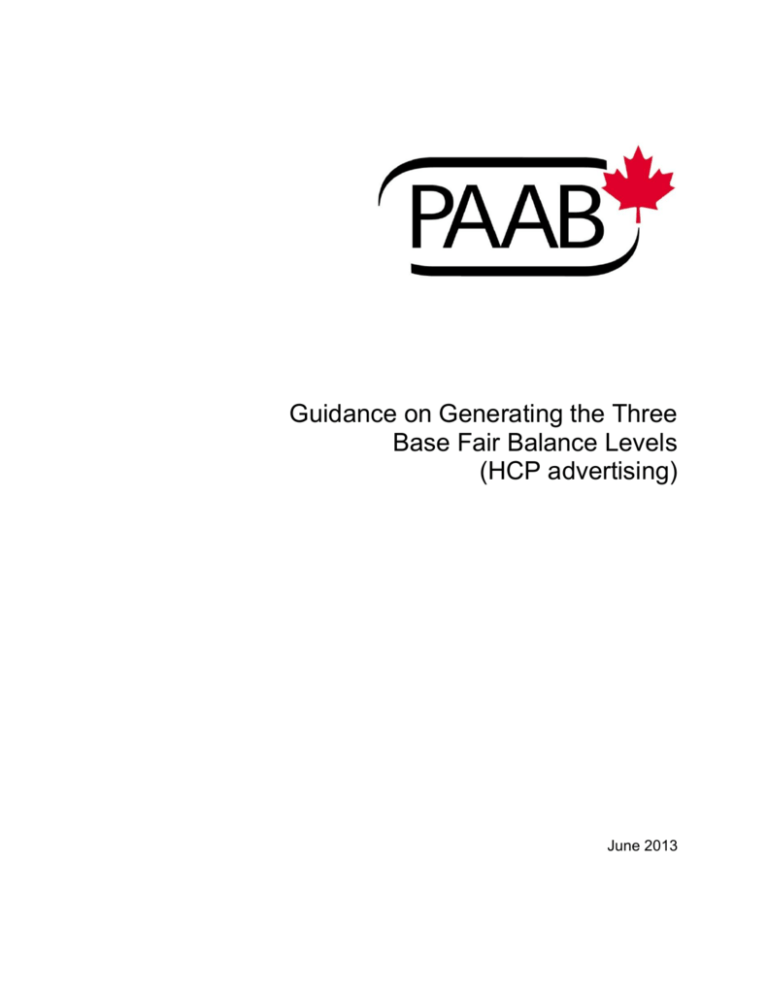
Guidance on Generating the Three Base Fair Balance Levels (HCP advertising) June 2013 Preamble: In alignment with section 9.1 of the Food and Drugs Act, the PAAB code sections 2.1, 2.4, and 3.5 require that risk information be: presented within the APS among the claims comprised of content type & quantity which adequately balances the claims accurate clear prominent This present document provides guidance developed by a committee of industry experts on how to meet the above requirements in the context of changes to PAAB code section 7.3. This guidance was designed to address Health Canada’s questions about fair balance while offering flexibility for the manufacturers. Scope of guidance provided herein: This document applies only to healthcare professional advertising/promotion systems (APS) that require fair balance per PAAB code sections 2.1, 2.4, 3.5, and 7.3. Overview: For any healthcare product, there are three levels of base fair balance. For simplicity, we’ve referred to them as: “Middle” Decreased Comprehensiveness “Highest” “Lowest” The pages that follow guide creation of these three fair balance levels. Once the three levels of fair balance are generated for a product, the manufacturer needs to determine which level is required in any given healthcare professional advertisement and where to place it in order to satisfy PAAB code section 2.1, 2.4, and 3.5. Refer to the PAAB guidance document “Guidance on base fair balance level selection and placement”. As described in that document, although only one level of fair balance is required to appear in any given APS, the manufacturers may elect to employ middle level fair balance to direct to the highest level elsewhere. 1 Clients may submit the 3 levels of New Fair Balance for line by line review; this is not an opinion review. Submit your New Fair Balance as an HCP Detail Aid. Identify in a cover letter that you are requesting review of the 3 levels of Fair Balance; the efile will be coded accordingly. PAAB will review this New Fair Balance in English, French or both languages and the normal fee schedule applies to these submissions. Turnaround time is 10 days for a first response and 3 days for revision. The PAAB will work toward “no further comments” before the file is complete and there is no acceptance granted, therefore, renewal is not required. Once “no further comments” has been reached, clients may insert the final New Fair Balance reviewed into future APS for review. Please note that ongoing pieces which are reviewed under the current code cannot be “converted” into new code reviews (i.e. this would trigger a new file and the corresponding fee). Constructing the highest level of base fair balance: Figure 1 provides the framework for the highest level. Note the following themes: Headings must be employed to signal the key fair balance sections. Each section heading is underlined and bolded. A line of white space separates each of the key sections (all 5 key sections are presented together in figure 1). Click on the yellow callout box for additional guidance. Jump ahead to figures 2 and 4 if you need help visualizing the guidance provided in these callouts. Figure 1: Framework for highest level fair balance Indications and clinical use: Contraindications: Most serious warnings and precautions: Bolded topic: Description of that risk Other relevant warnings and precautions: For more information: Bolded topic: Description of that risk Key principles to supplement the above framework: There is no need to include content relating to indications which are not promoted in the APS. The purpose of fair balance is to balance the claims made within the APS. Where multiple indications are promoted, it should be clear which warnings relate to which indications as per PAAB code section 2.1. 2 Content may be summarized provided the complete essence is captured. Risk information is not required to be presented verbatim from the TMA. Please note that the indication must appear verbatim at least once in the APS as per PAAB code section 2.10. There is no need to repeat content which is presented elsewhere in the piece. But manufacturers may elect to do so in order to maintain consistent fair balance segments across the campaign. When relevant content is excluded from these sections because they have been presented prominently elsewhere within the main marketing message, the section heading should be revised to convey this fact (e.g. “contraindications which have not been discussed elsewhere in the piece"). When an entire section has already been presented elsewhere in the piece, the entire section & title can be omitted from the standard fair balance. Manufacturers may still elect to spread fair balance throughout the APS. Content requirements are identical whether the risk information is presented together or spread throughout the APS. However, the headings are not required if this content is spread throughout the APS (provided the type of content is clearly conveyed). The headings are intended to clearly signal transition from one section to another when multiple sections are presented together. Risk elements which are bolded/boxed in the product monograph are not required to be bolded/boxed in the fair balance presentation: Aside from the bolding/underlining features of emphasis which are built into the fair balance framework, fair balance copy is not required to match level of emphasis in the TMA (e.g. by bolding, boxing, or underlining). The signaling and framing elements built into the above format contribute to an adequate level of emphasis (along with positioning factors discussed in the PAAB guidance document “Guidance on base fair balance level selection and placement”). Refer to the Health Canada Guidance Document “Notice of Compliance with Conditions (NOC/c)” and the PAAB guidance document “Guideline in Advertising Disclosure for Drugs with Notice of Compliance with Conditions (NOC/c)” for relevant disclosure requirements of the NOC/c box. This NOC/c statement is required to be boxed in the APS. However, it would not appear within the base fair balance (i.e. presented prior to base fair balance). Some content can be omitted at the manufacturer’s discretion: See the APPENDIX on page 10 for categories of information which can be omitted at the manufacturer’s discretion. Figure 2 on the next page is a copy deck example depicting one of the ways the highest level of base fair balance could be created for Cozaar. This fair balance has not been approved by Merck and is for training purposes only. 3 Figure 2: Example for Cozaar. Highest level fair balance. Indication & Clinical Use: COZAAR is indicated for the treatment of essential hypertension. Data in combination with betablockers and calcium channel blockers is limited. Safety and efficacy of concurrent use with angiotensin converting enzyme inhibitors have not been established. Antihypertensive effects demonstrated in pediatric patients aged 6 to 16 years. Most Serious Warnings and Precautions: Pregnancy: Can cause injury or death of the developing fetus. Discontinue as soon as possible upon discovery of pregnancy. Other Relevant Warnings and Precautions: Hypotension Decreased coronary perfusion Dosing adjustments in patients with current (or history of) hepatic impairment Renal impairment Hyperkalemia Anaphylactic reactions, angioedema, and vasculitis. For More Information: Please consult the product monograph at www.cozaar.ca/PM472 for important information relating to adverse reactions, drug interactions, and dosing information which have not been discussed in this piece. The product monograph is also available by calling us at 1-800-XXX-XXXX Figure 3 is a layout for a 2012 Toviaz journal ad. Figure 4 is a layout for that same ad modified to contain an example of the highest level of base fair balance for Toviaz. You’ll note that, unlike in the Cozaar example, there are only 4 headings (as Toviaz does not have boxed/bolded warnings). To learn how to make the ad look like Figure 5, you’ll need to read the PAAB guidance document “Guidance on base fair balance level selection and placement”. You may need to zoom-in to read the journal ads as they were shrunk to fit the page. 4 5 6 7 Constructing the middle level of base fair balance: It is simple to derive the middle base fair balance level from the highest level (i.e. construct the highest level first). In the middle level, the manufacturer may replace the clinical use content with a general instruction to refer to the TMA for information about clinical use1, replace descriptions of the most serious warnings and precautions with a list simply identifying them, and reformat the remaining information in the following condensed way: A single bullet leading-in with “Contraindications in” followed by a list identifying all contraindications which are material to the promoted use. A single bullet leading-in with “The most serious warnings and precautions regarding” followed by a list identifying all emphasized warnings and precautions from the TMA which are material to the promoted use.2 A single bullet leading-in with “Other relevant warnings and precautions regarding” followed by a list identifying all other warnings and precautions which are material to the promoted use.2 A bullet directing the HCP to the TMA for information relating to conditions of clinical use, adverse reactions, drug interactions and dosing/administration instructions. When multiple indications are promoted in the piece, it should be clear which indication each risk/burden pertains to. When relevant content is excluded from the sections “Contraindications”, "Serious Warnings and Precautions" and "Other Relevant Warnings and Precautions" (i.e. because it had already been prominently presented elsewhere within the main marketing message), the bullet’s lead-in should be revised to reflect this. e.g. “Contraindications not discussed elsewhere in the piece:” Figure 6 is a copy deck example depicting one of the ways the middle fair balance level could be created for Cozaar. This has not been approved by Merck and is for training purposes only. Figure 6: Example for Cozaar. Middle level fair balance. COZAAR is indicated for the treatment of essential hypertension. Consult the product monograph at www.cozaar.ca/PM635 for important information about: The most serious warning and precaution regarding risk of injury or death to fetus Other relevant warnings and precautions regarding hypotension, decreased coronary perfusion, renal impairment, hyperkalemia, anaphylactic reactions and angiodema. Conditions of clinical use, adverse reactions, drug interactions and dosing instructions The product monograph is also available through our medical department. Call us at 1-800-XXX-XXXX 1 Although the indication is required in the piece as per s2.10 of the PAAB code, the conditions of clinical use and data limitations conveyed in the “Indication and Clinical Use” section of a product monograph are not required in a piece qualifying for middle fair balance unless they limit patient selection. For example, a restriction which limits the duration of treatment to 8 weeks is not required to be presented in this context (whereas it was required in the highest level of base fair balance). As such, the words “conditions of clinical use” are added to the linkage statement. 2 Items may be grouped into categories considered by the PAAB to be adequately descriptive: e.g. warning regarding red blood cell reduction, white blood cell reduction, and platelet reductions may be identified as “reduction in blood cells” e.g. warning about risks pertaining to lymphoma, skin cancer, and lung cancer can be identified as “risks of malignancies”. 8 Figure 7 is a copy deck example depicting one of the ways the middle fair balance level could be created for Toviaz. This has not been approved by Pfizer and is for training purposes only. Figure 7: Example for Toviaz. Middle level fair balance (indication is elsewhere in the piece). Consult the product monograph at www.toviaz.ca/PM1583 for important information about: Contraindications in patients with urinary retention, gastric retention, uncontrolled narrow-angle glaucoma, hypersensitivity to tolterodine L-tartrate, soya, peanuts, lactose. Relevant warnings and precautions regarding increased heart rate, interaction with potent CYP3A4 inhibitors, patient at risk of gastric retention, patient at risk of urinary retention, patients with impaired hepatic function, angioedema, patients with myasthenia gravis, patients with controlled narrow-angle glaucoma, patients with impaired renal function, use of contraception in women of childbearing potential. Conditions of clinical use, adverse reactions, drug interactions, and dosing instructions. The product monograph is also available by calling us at 1-800-XXX-XXXX. Constructing the lowest level of base fair balance: The lowest level simply discloses that the product has contraindications, warnings, precautions, adverse reactions, interactions, dosing instructions and conditions of use and directs the HCP to the TMA to obtain information about these categories of risk/burden. The indication is also required in the APS. Risk/burden categories which are not relevant to that specific product’s TMA should be excluded from the referral statement. e.g. if there are no drug interactions in the TMA, “drug interactions” should not appear in the referral statement. This level of fair balance is accepted only in specific circumstances. Please refer to the PAAB guidance document “Guidance on base fair balance level selection and placement”. Figure 8 is a copy deck example depicting one of the ways the lowest fair balance level could be created for Cozaar. This has not been approved by Merck and is for training purposes only. Figure 8: Example for Cozaar. Lowest level fair balance. COZAAR is indicated for the treatment of essential hypertension. Consult the product monograph at www.cozaar.ca/PM321 for contraindications, warnings, precautions, adverse reactions, interactions, dosing, and conditions of clinical use. The product monograph is also available through our medical department. Call us at 1-800-XXX-XXXX 9 APPENDIX The following can be removed from the content pooled above: i. Content which applies to all categories of drugs irrespective of therapeutic area 3 e.g. contraindications in patients with known allergies against the product or its ingredients e.g. “only use in those who are pregnant/nursing where benefits exceed risks” is not required for systemic therapy. This applies across product categories. Note that stronger TMA directions to avoid/alter product use would be required. Also note that this copy is not as common for products which are applied topically (i.e. it should therefore be included for such products). ii. Instructions which are covered by standards of practice for all drug therapies e.g. only physicians who are knowledgeable in the product should prescribe product XYZ e.g. instruct patients to keep out of reach of children iii. Content which had been presented elsewhere in the piece i.e. not required to repeat the content (although the manufacturer may elect to do so for simplicity of having a consistent base of fair balance across similar APS) iv. Content which is promotional e.g. a warning whose magnitude of risk is stated in the monograph to be similar to placebo (unless TMA content still suggests a need for monitoring) e.g. positive outcomes described in clinical use section v. Content describing risks which have been demonstrated not to be associated with the product (unless TMA suggests potential risk or a need for monitoring) e.g. Drug XYZ was shown not to reduce renal function in humans. vi. Content about alternate therapeutic options in case of adverse effects on the sponsor’s product e.g. "Allergies to Arbace may not extend to other products in the ARB class, another ARB may be tried with caution". vii. Explanations why the product is contraindicated in certain populations i.e. the reader simply needs to know that the product is not to be used in that population. viii. Medical definitions & thresholds (except in the verbatim indication statement) E.g. no need to define the creatinine clearance threshold for “severe renal impairment“ ix. Examples are generally not required4. 3 However, in cases where the allergy statement includes discussion of specifics beyond simply the active ingredient(s), this segment should be included (e.g. contraindicated if allergies against a specific non-active ingredient or an ingredient origin). 4 Examples listed in any section of the TMA other than the indication are required to appear ONLY when: they relate to aspects specifically evaluated; they relate to aspects which are of particular importance over non-listed items; they materially affect the clarity/completeness of the statement E.g. content in green is required to appear while content in red is not: - Avoid use in patients on ACE inhibitors (e.g. ramipril) - Efficacy or safety has been evaluated in patients on the ACEIs ramipril and enalapril. - CYP450 inducers (e.g. Phenytoin, Phenobarbital) are expected to increase metabolism. - The following CYP450 inducers were found to increase metabolism: phenytoin, and phenobarbital. -CYP450 inducers can increase metabolism and significantly reduce blood levels (particularly phenytoin and phenobarbitol) - Contraindicated in patients at risk of bleeding (e.g. extensive cerebral infarction in last 6 months, active peptic ulcer disease with recent bleeding) 10
